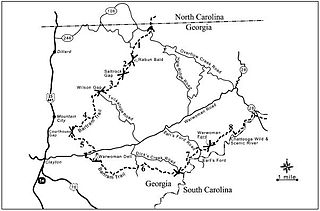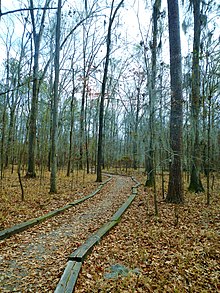
Elmore County is a county located in the east central portion of the U.S. state of Alabama. As of the 2020 census, the population was 87,977. Its county seat is Wetumpka. Its name is in honor of General John A. Elmore.

Tallapoosa County is a county located in the east-central portion of the U.S. state of Alabama. As of the 2020 census, the population was 41,311. Its county seat is Dadeville. Its largest city is Alexander City.

Wetumpka is a city in and the county seat of Elmore County, Alabama, United States. At the 2020 census, the population was 7,220. In the early 21st century, Elmore County became one of the fastest-growing counties in the state. The city is considered part of the Montgomery Metropolitan Area.

The Battle of Horseshoe Bend, was fought during the War of 1812 in the Mississippi Territory, now central Alabama. On March 27, 1814, United States forces and Indian allies under Major General Andrew Jackson defeated the Red Sticks, a part of the Creek Indian tribe who opposed American expansion, effectively ending the Creek War.

An arboretum is a botanical collection composed exclusively of trees and shrubs of a variety of species. Originally mostly created as a section in a larger garden or park for specimens of mostly non-local species, many modern arboreta are in botanical gardens as living collections of woody plants and are intended at least in part for scientific study.

William Bartram was an American naturalist, writer and explorer. Bartram was the author of an acclaimed book, now known by the shortened title Bartram's Travels, which chronicled his explorations of the Southern Colonies of British North America from 1773 to 1777. Bartram has been described as "the first naturalist who penetrated the dense tropical forests of Florida".

Pelham Bay Park is a municipal park located in the northeast corner of the New York City borough of the Bronx. It is, at 2,772 acres (1,122 ha), the largest public park in New York City. The park is more than three times the size of Manhattan's Central Park. The park is operated by the New York City Department of Parks and Recreation.

The Oxford University Parks, commonly referred to locally as the University Parks, or just The Parks, is a large parkland area slightly northeast of the city centre in Oxford, England. The park is bounded to the east by the River Cherwell, though a small plot of land called Mesopotamia sits between the upper and lower levels of the river. To the north of the parks are Norham Gardens and Lady Margaret Hall, to the west the Parks Road, and the Science Area on South Parks Road to the south. The park is open to the public during the day, and has gardens, large sports fields, and exotic plants. It includes a cricket ground used by Oxford University Cricket Club.

Bellingrath Gardens and Home is the 65-acre (26 ha) public garden and historic home of Walter and Bessie Bellingrath, located on the Fowl River near Mobile, Alabama, United States. Walter Bellingrath was one of the first Coca-Cola bottlers in the Southeast, and with his wealth built the estate garden and home. He and his wife, Bessie, lived in the home which has since been converted into a museum. The gardens opened to the public in 1932. The site was listed on the Alabama Register of Landmarks and Heritage on September 14, 1977, and on the National Register of Historic Places on October 19, 1982.

Painshill, near Cobham, Surrey, England, is one of the finest remaining examples of an 18th-century English landscape park. It was designed and created between 1738 and 1773 by Charles Hamilton. The original house built in the park by Hamilton has since been demolished.

The Woodlands is a National Historic Landmark District on the west bank of the Schuylkill River in Philadelphia. It includes a Federal-style mansion, a matching carriage house and stable, and a garden landscape that in 1840 was transformed into a Victorian rural cemetery with an arboretum of over 1,000 trees. More than 30,000 people are buried at the cemetery. Among the tombstones at Woodlands cemetery is the tombstone of Dr Thomas W. Evans, which at 150 feet (46 m), is both the tallest gravestone in the United States and the tallest obelisk gravestone in the world.

Bartram's Garden is a 50-acre public garden and National Historic Landmark in Southwest Philadelphia, Pennsylvania, situated on the banks of the Tidal Schuylkill River. Founded in 1728 by botanist John Bartram (1699–1777), it is the oldest botanical garden to survive in North America. The Garden is operated by the non-profit John Bartram Association in coordination with Philadelphia Parks and Recreation.

The Battle of Calebee Creek took place on January 27, 1814, during the Creek War, in Macon County, Alabama, 50 miles (80 km) west of Fort Mitchell. General Floyd, with 1,200 Georgia volunteers, a company of cavalry and 400 friendly Yuchi, repulsed a night attack of the Red Sticks on his camp. Floyd lost so many in this hostile country that he immediately withdrew to the Chattahoochee River. Also referred to as the Battle for Camp Defiance.

The Bartram Trail follows the approximate route of 18th-century naturalist William Bartram’s southern journey from March 1773 to January 1777. Bartram explored much of the territory which is now the states of North and South Carolina, Georgia, Florida, Alabama, Mississippi, Louisiana and Tennessee.

Fort Toulouse and Fort Jackson are two forts that shared the same site at the fork of the Coosa River and the Tallapoosa River, near Wetumpka, Alabama.
Hickory Ground, also known as Otciapofa is an historic Upper Muscogee Creek tribal town and an archaeological site in Elmore County, Alabama near Wetumpka. It is known as Oce Vpofa in the Muscogee language; the name derives from oche-ub,"hickory" and po-fau, "among". It is best known for serving as the last capital of the National Council of the Creek Nation, prior to the tribe being moved to the Indian Territory in the 1830s. It was added to the National Register of Historic Places on March 10, 1980.

Fort Decatur was an earthen fort established in March 1814 on the banks of the Tallapoosa River as part of the Creek War and the larger War of 1812. The fort was located on the east bank of the Tallapoosa River, near the modern community of Milstead. Fort Decatur was also located near the Creek town of Tukabatchee. It was most likely named for Stephen Decatur.

The Taskigi Mound or Mound at Fort Toulouse – Fort Jackson Park (1EE1) is an archaeological site from the South Appalachian Mississippian Big Eddy phase. It is located on a 40 feet (12 m) bluff at the confluence of the Coosa and Tallapoosa rivers where they meet to form the Alabama River, near the town of Wetumpka in Elmore County, Alabama.
Sehoy, or Sehoy I, was an 18th-century matriarch of the Muscogee Confederacy and a member of the Wind clan.

















